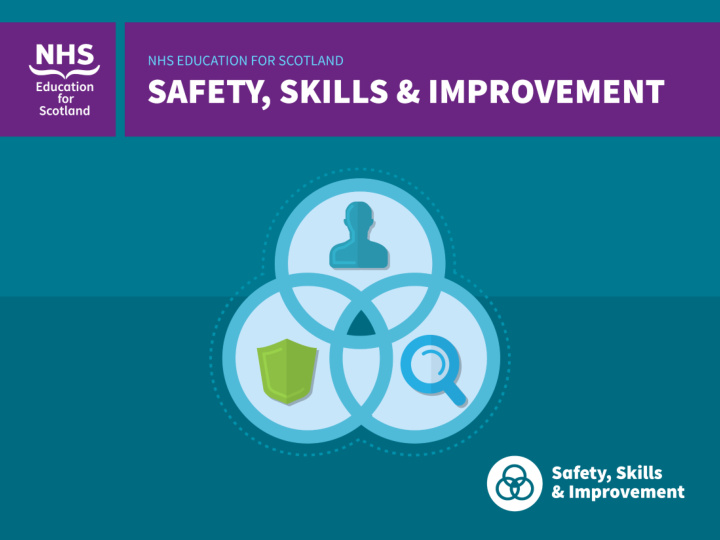



Faculty Development in Simulation – The National Outcomes Framework Advanced Programme for SBL Educator Introductory Programme for SBL Educator Awareness of Simulation to Educators
Tier 1 Awareness of Simulation to Educators 1. Describe range of appropriate learning activities that can use simulation 2. Recognise spectrum of simulation modalities 3. Recognise impact SBL can have on individual, team and system 4. Identify range of opportunities for faculty development in SBL 5. Recognise SBL in context of curriculum outcomes 6. Demonstrate awareness of where simulation can enhance curriculum delivery
Tier 2 Introductory Programme for SBL Educator 1. Identify appropriate learning outcomes for simulation based learning (SBL) event 2. Demonstrate appropriate underpinning educational theory 3. Design an SBL event taking account stage and expertise of learner 4. Design an SBL event utilising principles of deliberate practice and prevention of skill decay 5. Design an SBL event using principles of constructive alignment 6. Delivery of SBL event 7. Debrief and reflect on SBL event 8. Establish a safe learning environment for the SBL event 9. Evaluate SBL event using appropriate framework
Tier 3 Advanced Practitioner Programme for SBL Educator 1. Design, deliver and evaluate interprofessional SBL event 2. Evaluate role as SBL educator 3. Demonstrate use of simulation for assessment 4. Demonstrate skills with video debrief of SBL event 5. Identify and contribute to SBE research opportunities 6. Develop integrated curricular programme for SBL 7. Participate in learning from meta-debriefing 8. Provide leadership for SBE educators 9. Recognise need to link to appropriate statutory bodies 10. Manage resources effectively and efficiently
Agreed high level outcomes for simulation AOME Agreed high level outcomes for AOME Agreed high level outcomes for simulation based AOME based education at Tier 1 domains simulation based education Tier 2 Domains education Tier 3 Domains Describe range of appropriate learning 1.1.5, 2.1.1 Design, deliver and evaluate Interprofessional SBL 2.3.1 Identify appropriate learning outcomes 1.1.4 activities that can use simulation 2.1.5, 2.2.1 event for simulation based learning event 1.1.3 ( e.g. procedural skills, communication ( e.g. use of SMART, Blooms taxonomy ) skills, drills etc) Evaluate role as SBL educator 2.2.9 Demonstrate the appropriate 1.1.2, (e.g. for portfolio evidence, appraisal) 4.2.2 Recognise the spectrum of simulation underpinning educational theory 4.1.1 modalities ( e.g. behaviourism, experiential learning 4.2.1 Demonstrate use of simulation for assessment 3.1.1-6 (e.g. VR, part task, emulators, manikins, reflective practice, social cognitive (e.g. constructive alignment, immersion and and simulated patients ) theory, activity theory ) assessment; use of Millar’s triangle; Tools such as Recognise impact simulation based learning 1.3.2 Design a SBL event taking account stage 1.1.1 OSCE and OSCE variants, OSATS, Behavioural (SBL) can have on learner, team and system 2.3.10 and expertise of learner 1.1.3 marker systems, WSE tool) (e.g. knowledge, skills, drills and (E.g Dreyfus and Dreyfus, Benner performance) Challenge point framework, Perry ) Demonstrate skills with video debrief of SBL event 2.2.6, Design a SBL event utilising principles of 1.1.1 (e.g. book-marking, learning aligned selection, 2.3.8 deliberate practice and prevention of Identify the range of opportunities for 2.2.3 signposting, use of teaching moments) skill decay faculty development in simulation based ( e.g. Ericsson, paced education ) learning Identify and contribute research opportunities for 4.1.4, Design a SBL event using principles of 1.2.5 ( e.g. range of courses, programmes simulation based education 4.2.3, constructive alignment 4.1.1 masterclasses, degrees) (e.g. Multicentre trials, publications,) 4.3.5 (e.g Biggs) Develop integrated curricular programme for SBL 1.3.1 Delivery of SBL Activity 2.1.1 Recognise SBL in context of curriculum 1.3.2 (e.g. integrated, progressive development of (E.g. Immersion using STEPS or 4 stage, outcomes knowledge, skills, drills and performance ) reflective immersion, (e.g. Tomorrows Doctors, Foundation and use of faculty confederate Simulated specialty competency based curricula, Participate in learning from meta-debriefing (E.g. 2.3.7, patients and or simulators) NMC, ) Debrief and reflect on the SBL event 2.1.4, DASH, OSAD, peer review debriefing) 2.3.11 (use of relevant models, e.g. agenda led- 2.1.6 Demonstrate awareness of mapping where 1.2.5 Provide leadership for SBE educators 5.1.3 outcomes based, description-analysis- 2.2.6, simulation can enhance curriculum delivery (e.g. organisations such as universities NHS application, learning conversation) 2.2.7 (e.g. Blue print vs curriculum ) organisations, societies and associations) Establish a safe learning environment for 2.1.2, Recognise need to link to statutory and regulatory 5.1.4 the SBL event 2.2.2, bodies (e.g. GMC, NMC, HPC) ( e.g. Confidentiality, consent, ground 2.3.4 Manage resources effectively and efficiently ( e.g. 5.2.1 rules, time out ) use of simplest possible simulator, procurement of Evaluate SBL event using appropriate 1.1.6, consumables, development of patient banks ) framework 1.2.7 ( eg Realistic evaluation, Kirkpatrick levels, DASH Student version )
Roundtable Discussion Discuss at tables 1. Are learners well prepared for face to face(FTF) simulation based education interventions? 2. How can we most effectively enhance preparation of learners for FTF simulation based education interventions? 3. In relation to 2 what would main challenges be in assuring quality of intervention?
Quality Health Care Safe • • Effective • Person-centred • Timely • Efficient • Equitable The Health Foundation Adapted from dimensions of Quality identified Person-Centred Care made simple, 2014 Institute of Medicine Crossing the Quality Chasm 2001
Recommend
More recommend